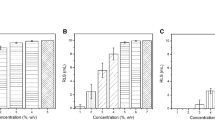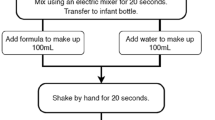Abstract
Dysphagia has been associated with a high risk of undernutrition and aspiration pneumonia in the elderly. It is commonly managed by adding commercial thickening agents to thicken liquids. The rheological behavior of these thickeners in water is known but there is lack of information with regard to other liquids. The aim of this study was to determine the viscosity of 11 beverages after adding commercial thickeners and to compare their viscosity with that of thickened water and also with the reference limits of the National Dysphagia Diet (NDD). We added starch-based and gum-based thickeners to 11 beverages to achieve a honey-like consistency. The 11 beverages were five juices (apple, orange, grape, peach-grape, and pineapple), two teas (black tea and chamomile), milk (whole and skimmed), instant coffee, and a vegetable milk (tigernut milk). Viscosity measurements were made in a controlled environment for the resulting 22 samples. Compared to thickened water, significant changes were found for all beverages except apple juice, with both starch- and gum-based thickeners, and orange juice, pineapple juice, and chamomile with the gum-based thickener. Results with respect to the NDD reference limits showed significant changes in viscosity only for peach-grape juice and pineapple juice with starch-based thickener. These findings show that changes arise in the viscosity of some thickened beverages compared to thickened water and also compared to the range recommended by the NDD. Further studies are needed to describe the rheological behavior of other beverages, thickeners, and consistencies. Recommendations to ensure feeding safety may be required for elderly patients with dysphagia.
Similar content being viewed by others
References
Rofes L, Arreola V, Almirall J, Cabré M, Campins L, García-Peris P, et al. Diagnosis and management of oropharyngeal dysphagia and its nutritional and respiratory complications in the elderly. Gastroenterol Res Pract. 2011;. doi:10.1155/2011/818979.
Clavé P, Verdaguer A, Arreola V. Oral-pharyngeal dysphagia in the elderly. Med Clin (Barc). 2005;124(19):742–8.
Steele CM, Miller AJ. Sensory input pathways and mechanisms in swallowing: a review. Dysphagia. 2010;25(4):323–33.
Matsuo K, Palmer JB. Anatomy and physiology of feeding and swallowing: normal and abnormal. Phys Med Rehabil Clin N Am. 2008;19(4):691–707.
Sura L, Madhavan A, Carnaby G, Crary MA. Dysphagia in the elderly: management and nutritional considerations. Clin Interv Aging. 2012;7:287–98.
Cichero JAY, Altman KW. Definition, prevalence and burden of oropharyngeal dysphagia: a serious problem among older adults worldwide and the impact on prognosis and hospital resources. Nestle Nutr Inst Workshop Ser. 2012;72:1–11.
Serra-Prat M, Hinojosa G, López D, Juan M, Fabré E, Voss DS, et al. Prevalence of oropharyngeal dysphagia and impaired safety and efficacy of swallow in independently living older persons. J Am Geriatr Soc. 2011;59(1):186–7.
Roy N, Stemple J, Merrill RM, Thomas L. Dysphagia in the elderly: preliminary evidence of prevalence, risk factors, and socioemotional effects. Ann Otol Rhinol Laryngol. 2007;116(11):858–65.
Lee A, Sitoh YY, Lieu PK, Phua SY, Chin JJ. Swallowing impairment and feeding dependency in the hospitalised elderly. Ann Acad Med Singap. 1999;28(3):371–6.
Lin LC, Wu SC, Chen HS, Wang TG, Chen MY. Prevalence of impaired swallowing in institutionalized older people in Taiwan. J Am Geriatr Soc. 2002;50(6):1118–23.
Clavé P, Rofes L, Carrión S, Ortega O, Cabré M, Serra-Prat M, et al. Pathophysiology, relevance and natural history of oropharyngeal dysphagia among older people. Nestle Nutr Inst Workshop Ser. 2012;72:57–66.
Foley NC, Martin RE, Salter KL, Teasell RW. A review of the relationship between dysphagia and malnutrition following stroke. J Rehabil Med. 2009;41(9):707–13.
Leibovitz A, Baumoehl Y, Lubart E, Yaina A, Platinovitz N, Segal R. Dehydration among long-term care elderly patients with oropharyngeal dysphagia. Gerontology. 2007;53(4):179–83.
Baine WB, Yu W, Summe JP. Epidemiologic trends in the hospitalization of elderly medicare patients for pneumonia, 1991–1998. Am J Public Health. 2001;91(7):1121–3.
Martino R, Foley N, Bhogal S, Diamant N, Speechley M, Teasell R. Dysphagia after stroke: incidence, diagnosis, and pulmonary complications. Stroke. 2005;36(12):2756–63.
Volkert D, Berner YN, Berry E, Cederholm T, Coti Bertrand P, Milne A, et al. ESPEN guidelines on enteral nutrition: geriatrics. Clin Nutr. 2006;25(2):330–60.
Ekberg O, Hamdy S, Woisard V, Wuttge-Hannig A, Ortega P. Social and psychological burden of dysphagia: its impact on diagnosis and treatment. Dysphagia. 2002;17(2):139–46.
Altman KW, Yu GP, Schaefer SD. Consequence of dysphagia in the hospitalized patient: impact on prognosis and hospital resources. Arch Otolaryngol Head Neck Surg. 2010;136(8):784–9.
Cabre M, Serra-Prat M, Palomera E, Almirall J, Pallares R, Clavé P. Prevalence and prognostic implications of dysphagia in elderly patients with pneumonia. Age Ageing. 2010;39(1):39–45.
Karagiannis MJP, Chivers L, Karagiannis TC. Effects of oral intake of water in patients with oropharyngeal dysphagia. BMC Geriatr. 2011;11:9.
Hanson B, O’Leary MT, Smith CH. The effect of saliva on the viscosity of thickened drinks. Dysphagia. 2012;27(1):10–9.
Bhattacharyya N, Kotz T, Shapiro J. The effect of bolus consistency on dysphagia in unilateral vocal cord paralysis. Otolaryngol Head Neck Surg. 2003;129(6):632–6.
Logemann JA, Gensler G, Robbins J, Lindblad AS, Brandt D, Hind JA, et al. A randomized study of three interventions for aspiration of thin liquids in patients with dementia or Parkinson’s disease. J Speech Lang Hear Res. 2008;51(1):173–83.
Rofes L, Arreola V, Romea M, Palomera E, Almirall J, Cabré M et al. Pathophysiology of oropharyngeal dysphagia in the frail elderly. Neurogastroenterol Motil. 2010;22(8):851–8, e230.
Regan J. Texture Modified Diet (TMD) and tube feeding. In: Ickenstein GW, editor. Diagnosis and treatment of neurogenic dysphagia. 1st ed. Bremen: UNI-MED Verlag AG; 2011. p. 69–78.
Garcia JM, Chambers E, Matta Z, Clark M. Viscosity measurements of nectar- and honey-thick liquids: product, liquid, and time comparisons. Dysphagia. 2005;20(4):325–35.
National Dysphagia Diet Task Force. National dysphagia diet: standardization for optimal care. Chicago: American Dietetic Association; 2002.
Garin N, De Pourcq JT, Cardona D, Martín-Venegas R, Gich I, Cardenete J, et al. Viscosity changes in thickened water due to the addition of highly prescribed drugs in geriatrics. Nutr Hosp. 2012;27(4):1298–303.
Dietitians Association of Australia and the Speech Pathology Association of Australia Limited. Texture-modified foods and thickened fluids as used for individuals with dysphagia: Australian standardised labels and definitions. Nutr Diet. 2007;64(s2):S53–76.
Seo CW, Yoo B. Steady and dynamic shear rheological properties of gum-based food thickeners used for diet modification of patients with dysphagia: effect of concentration. Dysphagia. 2013;28(2):205–11.
Hanson B, Cox B, Kaliviotis E, Smith CH. Effects of saliva on starch-thickened drinks with acidic and neutral pH. Dysphagia. 2012;27(3):427–35.
Dewar RJ, Joyce MJ. Time-dependent rheology of starch thickeners and the clinical implications for dysphagia therapy. Dysphagia. 2006;21(4):264–9.
Germain I, Dufresne T, Ramaswamy HS. Rheological characterization of thickened beverages used in the treatment of dysphagia. J Food Eng. 2006;73(1):64–74.
Kuhlemeier KV, Palmer JB, Rosenberg D. Effect of liquid bolus consistency and delivery method on aspiration and pharyngeal retention in dysphagia patients. Dysphagia. 2001;16(2):119–22.
Burton S, Laverty A, Macleod M. The dietitian’s role in diagnosis and treatment of dysphagia. In: Ekberg O, editor. Dysphagia: diagnosis and treatment. Heidelberg: Springer; 2012. p. 507–18.
AIJN European Fruit Juice Association. 2012 Liquid Fruit: Market Report. 2012. Available at http://www.aijn.org/pages/main/file.handler?f=AIJNMarketReport2012.pdf. Accessed 6 June 2013.
Centre for the Promotion of Imports from Developing Countries, Ministry of Foreign Affairs of the Netherlands. The EU market for herbal infusions, CBI Market Information Database, 2008. Available at http://www.cbi.eu/system/files/marketintel/200820-20Herbal20infusions. Accessed 6 June 2013.
Payne C, Methven L, Fairfield C, Bell A. Consistently inconsistent: commercially available starch-based dysphagia products. Dysphagia. 2011;26(1):27–33.
Hines S, McCrow J, Abbey J, Gledhill S. Thickened fluids for people with dementia in residential aged care facilities. Int J Evid Based Healthc. 2010;8(4):252–5.
Author information
Authors and Affiliations
Corresponding author
Rights and permissions
About this article
Cite this article
Garin, N., De Pourcq, J.T., Martín-Venegas, R. et al. Viscosity Differences Between Thickened Beverages Suitable for Elderly Patients with Dysphagia. Dysphagia 29, 483–488 (2014). https://doi.org/10.1007/s00455-014-9533-x
Received:
Accepted:
Published:
Issue Date:
DOI: https://doi.org/10.1007/s00455-014-9533-x




